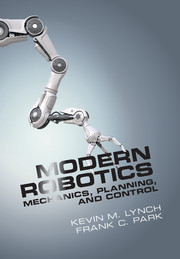Book contents
- Frontmatter
- Contents
- Foreword by Roger Brockett
- Foreword by Matthew Mason
- Preface
- 1 Preview
- 2 Configuration Space
- 3 Rigid-Body Motions
- 4 Forward Kinematics
- 5 Velocity Kinematics and Statics
- 6 Inverse Kinematics
- 7 Kinematics of Closed Chains
- 8 Dynamics of Open Chains
- 9 Trajectory Generation
- 10 Motion Planning
- 11 Robot Control
- 12 Grasping and Manipulation
- 13 Wheeled Mobile Robots
- A Summary of Useful Formulas
- B Other Representations of Rotations
- C Denavit–Hartenberg Parameters
- D Optimization and Lagrange Multipliers
- Bibliography
- Index
B - Other Representations of Rotations
Published online by Cambridge University Press: 04 June 2024
- Frontmatter
- Contents
- Foreword by Roger Brockett
- Foreword by Matthew Mason
- Preface
- 1 Preview
- 2 Configuration Space
- 3 Rigid-Body Motions
- 4 Forward Kinematics
- 5 Velocity Kinematics and Statics
- 6 Inverse Kinematics
- 7 Kinematics of Closed Chains
- 8 Dynamics of Open Chains
- 9 Trajectory Generation
- 10 Motion Planning
- 11 Robot Control
- 12 Grasping and Manipulation
- 13 Wheeled Mobile Robots
- A Summary of Useful Formulas
- B Other Representations of Rotations
- C Denavit–Hartenberg Parameters
- D Optimization and Lagrange Multipliers
- Bibliography
- Index
Summary
Euler Angles
As we established earlier, the orientation of a rigid body can be parametrized by three independent coordinates. For example, consider a rigid body with a body frame ﹛b﹜ attached to it, initially aligned with the space frame ﹛s﹜. Now rotate the body by α about the body ẑb-axis, then by β about the body ˆyb-axis, and finally by γ about the body ˆxb-axis. Then (α, β, γ) are the ZYX Euler angles representing the final orientation of the body (see Figure B.1). If the successive rotations are made with respect to the body frame, the result corresponds to the final rotation matrix
where
Writing out the entries explicitly, we get
where sα is shorthand for sinα, cα for cos α, etc.
We now ask the following question: given an arbitrary rotation matrix R, does there exist (α, β, γ) satisfying Equation (B.1)? In other words, can the ZYX Euler angles represent all orientations? The answer is yes, and we prove this fact constructively as follows. Let rij be the (i, j)th element of R. Then, from Equation (B.1), we know as long as cos β= 0, or equivalently β= ±90, we have two possible solutions for β:
(The atan2 two-argument arctangent is described at the beginning of Chapter 6.) In the first case β lies in the range [−90◦, 90◦], while in the second case it lies in the range [90◦, 270◦]. Assuming that the β obtained above is not ±90◦, α and γ can then be determined from the following relations:
In the event that β = ±90◦, there exists a one-parameter family of solutions for α and γ. This is most easily seen from Figure B.3. If β = 90◦ then α and γ represent rotations (in the opposite direction) about the same vertical axis.
- Type
- Chapter
- Information
- Modern RoboticsMechanics, Planning, and Control, pp. 497 - 505Publisher: Cambridge University PressPrint publication year: 2017

